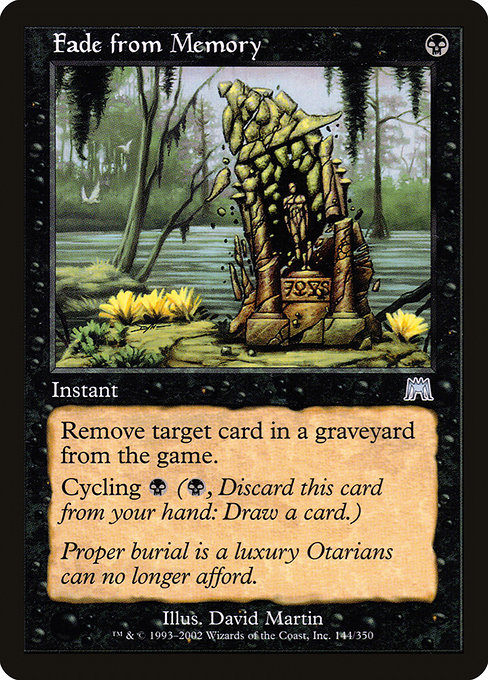
Image courtesy of Scryfall.com
Evaluating Innovation Risk in Fade from Memory’s Design
In the long arc of MTG design, Fade from Memory stands as a compact study in how a single card can balance two opposing urges: utility and restraint. This Onslaught-era instant, priced at a lean {B}, asks players to weigh disruption against self-sufficiency, all while offering a neat lane for deck-building creativity through cycling. 🧙♂️ The card’s text is a clean handshake between two distinct ideas: exile a card from a graveyard to shut down recursion, and cycle for card draw to pressure your own resource curve. The result is a design that rewards tactical timing and thoughtful sequencing, even as it risks tipping into overpowering coverage if not kept in check. 🔥
From a design perspective, the beauty and risk lie in how this single spell threads the needle between graveyard hate and card economy. Exiling a card from a graveyard literally denies an opponent potential plays—think of it as a targeted roadblock for strategies built around reanimation or value engines. Yet the same card can cycle away for a draw, offering a second life to a hand that might have otherwise stall. That duality is a trapdoor: it invites creative uses, but it also invites decks to stack too many “feel-bad” moments into a single play. The black color identity and the {B} mana cost anchor it firmly in the strategy space black often inhabits—resource denial, selective removal, and late-game inevitability—while its cycling ability nudges players toward tempo-rich gameplay. ⚔️
Design mechanics and the risk calculus
- Graveyard exile as a focused tool: Exiling a card from a graveyard is precise and situational. It can disable a key combo or stall a critical engine, but it’s not mass-removal or unconditional graveyard hate. This precision is both strength and risk: it favors players who time it well, but it may feel underpowered in the face of broad, generic graveyard strategies.
- Cycling as a balancing act: The cycling cost of {B} doubles as a loop for card advantage, yet it requires sacrificing the card itself. This creates an economy of decisions: is the exile effect worth the potential draw later in the game? For design, the risk is rendering cycling too powerful when paired with strong self-mraudering or graveyard manipulation that benefits from cheap card draw.
- Set and rarity context: In Onslaught (set type: expansion, released 2002), this card found a home among a relatively tight power spectrum. Uncommon rarity and foil variants present a price floor and ceiling that matter for collector perception. The balance is purposeful: not a fearsome staple in every black deck, but a credible tool that can shine in the right shell. 💎
- Flavor and world-building tie-in: The flavor text—“Proper burial is a luxury Otarians can no longer afford.”—adds narrative weight to the mechanical choice. When design teams thread lore into mechanics, they raise the stakes of each decision, and Fade from Memory leans into that with a grim elegance. 🎨
Exile target card from a graveyard. Cycling {B} ({B}, Discard this card: Draw a card.)
From a strategic vantage point, Fade from Memory invites black decks to engage on two tracks at once: deny and draw. In a pinch, you can use it as a tempo play to deny a single graveyard-oriented threat while maintaining card flow through cycling. It’s the kind of card that shines in midrange or control-adjacent shells where late-game inevitability and graveyard hate converge. For newer players, it’s a crisp lesson in how a small, well-timed interruption can tilt the momentum of a game, without needing to answer every threat on the board in a single blow. 🧙♂️🔥
Art, lineage, and market sense
The artwork by David Martin carries a stark, somewhat somber mood that matches the flavor of Otarians confronting mortality in a world where burial is no longer guaranteed. The black frame and subdued palette reflect the card’s role as a precise, somber intervention. The rarity—uncommon with a foil option—places Fade from Memory in a sweet spot for collectors who appreciate intelligent design without tipping into “must-run” archetype status. For market watchers, the card’s foil price around $1.58 and nonfoil around $0.20 (as of the data snapshot) illustrate how a well-crafted, era-defining card can accrue value through nostalgia and playability, even when it’s not a top-tier staple. In EDH, the card carries some presence, evidenced by its EDHREC rank in the 21,000s, signaling a niche but meaningful footprint in larger, casual playgroups. ⚔️
As designers continue to navigate the tension between niche-power and broad utility, Fade from Memory offers a case study in restraint with outsized thematic payoff. It teaches that innovation isn’t just about new effects; it’s about how those effects land within a broader ecosystem of formats, archetypes, and supply constraints. The risk remains: a design that leans too heavily on a single mechanic—gracefully integrated as it may be—can become a solvable problem, or conversely, a recurring source of frustration in formats where graveyard interaction is rampant. The balancing act is as delicate as a well-timed draw step, and this card remains a thoughtful reminder of why MTG design deserves a standing ovation for both its audacity and its discipline. 🧙♂️💎
Rectangular Gaming Mouse Pad Personalized Desk Mat 1.58 mmProduct cross-pollination is a small, appreciated practice in our community: a comfortable desk companion can accompany late-night drafting sessions, battles on the kitchen table, or competitive tournaments. While Fade from Memory itself may exile a single card for a moment, a well-chosen workspace accessory can help you stay sharp as you weigh each decision in the moment of play. 🧙♂️🎲
More from our network
- https://blog.digital-vault.xyz/blog/post/dr3-data-tests-main-sequence-relations-in-hot-giant/
- https://transparent-paper.shop/blog/post/designing-social-media-content-calendar-templates-that-drive-consistency/
- https://blog.digital-vault.xyz/blog/post/jumbo-imp-design-adaptation-between-physical-and-digital-mtg/
- https://blog.digital-vault.xyz/blog/post/card-art-evolution-in-modern-mtg-exit-through-the-grift-shop/
- https://blog.digital-vault.xyz/blog/post/blue-giant-at-5200-light-years-illuminates-radial-velocity-of-the-milky-way/